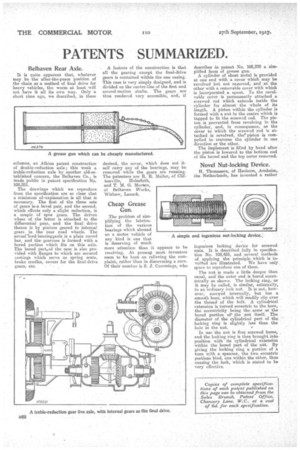PATENTS SUMMARIZED.
Page 22

If you've noticed an error in this article please click here to report it so we can fix it.
Belhaven Rear Axle.
It is quite apparent that, whatever may be the after-the-peace position of the chain as a method of final drive for heavy vehicles, the worm at least will not have it all its own way. Only a short time ago, we described, in these columns, an Albion patent construction of double-reduction axle; this week a treble-reduction axle by another old-established concern, the Belhaven Co., is made public in patent specification No. 108,251.
The drawings which we reproduce from the specification are so clear that a minimum of ,expianation is all that is necessary. The first of the three sets of gears ts,a bevel pair, and the second, which effects only a slight reduction, is a couple of spur gears. The driven wheel of. the latter is -attached to the differential gear, and the final'. drive thence is by pinions geared to internal gears in the rear road wheels. The actuarload-bearinglaxle is a plain round bar, and the, gea,rcase is formed with a bored portion which fits on this axle. The bored part„,of the case is also provided with flanges to which are secured castings which serve as spring seats, brake cradles, covers for the final-drive
gears, etc. _ A feature of the construction is that all the gearing except the final-drive gears is contained within the one casing. This case is very simply designed, and is divided on the centre-line of the first and second-motion shafts. The gears are thus rendered very accessible, and, if
Cheap Grease Gun.
The problem of simplifying the lubrication of the various bearings which abound on a motor vehicle of any kind is one that is deserving of much more attention than it appears to be receiving. At present most inventors seem to be bent on relieving the complaint, rather than in discovering a cure. Of their number is S. J. Cummings, who re#
describes in patent No. 108,370 a simplified form of grease gun. A cylinder of sheet metal is provided at one end with a cover which may be revolved but not removed, and at the other with a removable cover with which is incorporated a spout. To the revolvable cover is permanently attached a screwed rod which extends inside the cylinder for almost the whole of its length. A piston within the cylinder is formed with a nut in the centre which is tapped to fit the screwed rod. The piston is prevented from revolving in the cylinder, and, in consequence, as the cover to which the screwed rod is attached is revolved, thepiston is compelled to traverse the cylinder in one direction or the other.
The implement is filled by hand after the piston is lowered to the bottom end of the barrel and the top cover removed.
Novel Nut-locking Device.
Thomassen, of Heelsum, Arnheim, the Netherlands, has invented a rather ingenious locking device for screwed nuts. It is described fully in specification No. 108,435, and several methods of applying the principle which is invol/ed are illustrated. We have only space to reproduce one of them.
The nut is made a little deeper than usual, and the outer end is bored eccentrically as shown. The locking ring, as it may be called, is similar, externally, to an ordinary lock nut. It is not, however, screved internally, but has a smooth bore; which will readily slip over the thread of the bolt. A cylindrical extension is turned eccentric to the bore, the eccentricity being the same as the bored portion of' the nut itself. The diameter of the cylindrical part of the locking ring is slightly less than the hole in the nut.
In use the nut is first screwed home, and the locking ring is then brought into position with its cylindrical extension within the bored part of the -nut. By giving the locking ring a portion of a turn with a spanner, the two eccentric portions bind, one within the other, thus causing the lock, which is stated to be very effective.






















